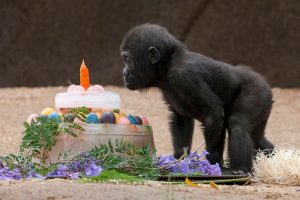Zoo InternQuest is a seven-week career exploration program for San Diego County high school juniors and seniors. Students have the unique opportunity to meet professionals working for the San Diego Zoo, Safari Park, and Institute for Conservation Research, learn about their jobs, and then blog about their experience online. Follow their adventures here on the Zoo’s website!
 They say, an apple a day keeps the doctors away, but that slogan doesn’t work for exotic zoo animals from all over the globe. Each species has there own specialized diet to help them be happy and healthy. The people who are in charge of creating the menus for the animals are called nutritionists. This week, interns had the unique opportunity to meet with Nutritional Services Supervisor Deborah Lowe and Associate Nutritionist Katie Kerr. Interns were taken behind the scenes to where all of the food for the animals is stored and prepared.
They say, an apple a day keeps the doctors away, but that slogan doesn’t work for exotic zoo animals from all over the globe. Each species has there own specialized diet to help them be happy and healthy. The people who are in charge of creating the menus for the animals are called nutritionists. This week, interns had the unique opportunity to meet with Nutritional Services Supervisor Deborah Lowe and Associate Nutritionist Katie Kerr. Interns were taken behind the scenes to where all of the food for the animals is stored and prepared.
Each animal at the zoo has a specialized diet. Animals are separated into groups such as carnivores, herbivores, and omnivores. The warehouse is set up in a similar way, where they keep the meats and the produce completely separate to avoid cross contamination. The warehouse has a total of four cooling units. The produce is kept at a comfortable 40 degrees Fahrenheit, meat is at 35 degrees, fish at negative ten degrees, and meat, mice and rats are at zero degrees. Each cooling unit has an alarm that is temperature sensitive that can alert nutritionists and forage warehouse staff if the temperature changes too drastically.
Each animal has their own diet chart. The nutritionists job is to keep records on each animal’s diet, which ensures they are getting the nutrition they need. Their job is challenging because there are around 4,000 animals at the zoo that they are in charge of feeding, each with their own individual diet plan. The food that is ordered comes from companies used by restaurants and schools, so they know the animals are getting top quality food. They have a $125,000 monthly budget for food, $8,000 of that goes to produce. They buy in bulk to be cost effective. When asked if they prefer organic, the explained that they tend to not buy organic products because it does not preserve very well. Bugs however need organic food because the risk of pesticides use is too high. In addition to buying meat and produce, they also buy flax oil and make there own primate gel to add to the food. Both flax oil and primate gel add calories to a meal and have omega 3 fatty acids which help reduce risk factors of heart disease, including high cholesterol and high blood pressure.
As for meat, it’s kept frozen at zero degrees and taken out to put into 35 degrees so it can defrost. The meat is separated into compartments organized by the day they are to be fed. The butcher boy, which is a saw used by the forage warehouse staff, slices the meat into smaller portions for the animals to help avoid wasting food. They carry a wide selection of meat such as beef spleen for the condors, and beef shanks for the large carnivores. In addition to the vast amount of beef, they carry a variety of mice and rats. Mice are separated by size starting at pinkies, which are the smallest size, fuzzies, hoppers and 10 grams and 20 grams mice.
In addition to meat and produce, the nutritionists and the warehouse team are in charge of the grain, hay and insect warehouses. The grain warehouse is full of all different kinds of grain from puppy kibble and horse pellets to primate chow. However, the food that they buy is not species specific. For instance, dog kibble may be added to water and sprinkled over the food for the birds to add protein to a meal. The hay room contains three different kinds of hay including alfalfa, bermuda, and sudan. Nutritionists take a sample of the hay to go to the lab for analysis. This is to make sure that the hay has the correct amount of vitamins and nutrients needed to maintain the health of the animals. The bug room contains crickets and mealworms. They carry refrigerated mealworms and live mealworms for the animals. Mealworms can be gut loaded to help the collection animals get more calcium.
In the warehouse they have items such as crunchy peanut butter to help feed animals pills. This way the animal cannot tell what is peanut and what is pill. They also have things like gatorade for the primates to help administer medicine. The gatorade is diluted with water, but the taste helps mask the taste of the medication. Some of the fun parts of the job may include making specialized birthday cakes for the animals. The zoo recently had their 100-year anniversary. In celebration, the nutritionists made a cake for the primates out of hibiscus flowers and yams.
Being a nutritionist is a very important job, not only for humans but for animals too. It’s important to make sure the animal is healthy to help support its immune system, growth, and reproductive system. They help replicate an animal’s diet as it would be in the wild to help them live as natural a life as possible. Thanks to nutritionists, animals can live a deliciously healthy life.
Teah, Real World
Week Six, Fall Session 2016


